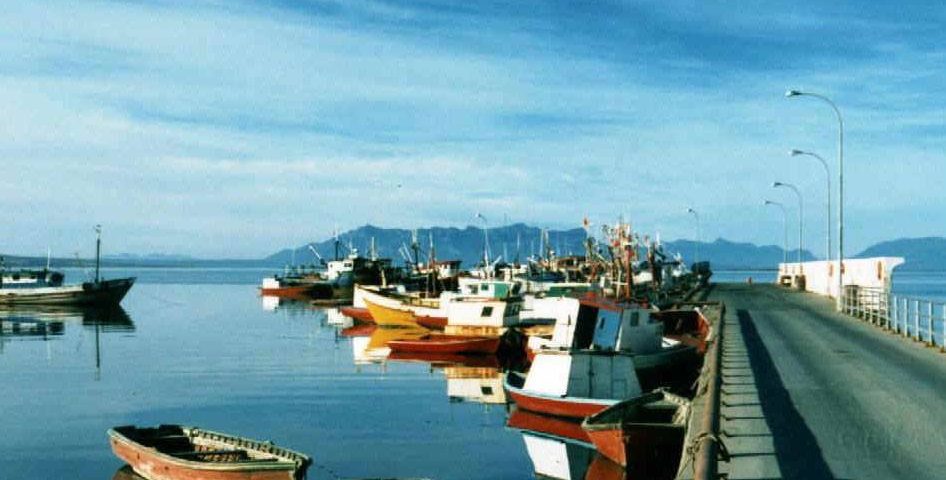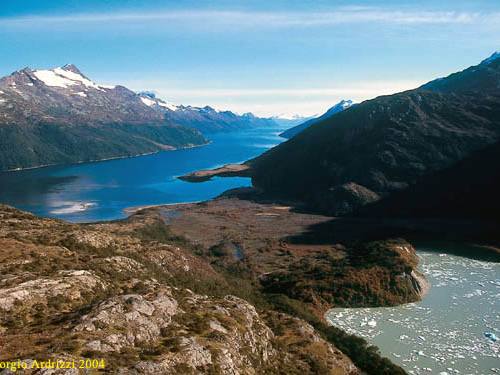Torres del Paine and Puerto Natales

General Carrera Lake and Baker River

Land of Fire

1647/5000
At only 247 kms. to the northeast of Punta Arenas, Puerto Natales receives the visitor with its characteristic black-necked swans and seagulls, in the midst of a misty pier that invites tourists to discover one of the most enigmatic places in Chile. Puerto Natales, which comes from the Latin term or birth, is the provincial capital of Última Esperanza, is located at sea level on the edge of Señoret Canal and in front of the Patagonian Andes, being the gateway to beautiful natural landscapes recognized worldwide, such as the Cueva del Milodon Natural Monument and Los Glaciares National Park, the ski fields in Río Turbio, as well as the seven glaciers located in the Canal de las Montañas, lagoons Sofía, Diana and Dorotea; Balmaceda and Toro lakes; Dorotea and Prat hills, Admiral Montt gulf, Swan and Guanaco islands, Bories and Consuelo ports, Fiscal dock, Costanera Avenue, Kirke Pass, Antonio Varas peninsula, Serrano and Tres Pasos Rivers, D`Agostini Museum, Bernardo National Park O'Higgins, where the Balmaceda and Serrano glaciers are located, Mount Balmaceda, Pío XI glacier and Campos de Hielo Sur.
However, there is a place, which they say is one of the natural wonders of the planet, becomes the main attraction of the Patagonian region: Las Torres del Paine. Located in the XII Region of Chile, 145 kms. from Puerto Natales, between the Cordillera de Los Andes massif and the Patagonian Steppe, through the south-western end of the area is the Fairway Lighthouse, which is located at the mouth of the Strait of Magellan towards the Pacific Ocean.
However, there is a place, which they say is one of the natural wonders of the planet, becomes the main attraction of the Patagonian region: Las Torres del Paine. Located in the XII Region of Chile, 145 kms. from Puerto Natales, between the Cordillera de Los Andes massif and the Patagonian Steppe, through the south-western end of the area is the Fairway Lighthouse, which is located at the mouth of the Strait of Magellan towards the Pacific Ocean.
Created in 1959 and declared a Biosphere Reserve by UNESCO in 1978, the Torres del Paine National Park covers an area of 242,242 hectares, with an altitude ranging from 200 meters. up to 3,050 meters. (Macizos del Paine) above sea level. It has 3 access roads: Portería Sarmiento, Laguna Amarga and Laguna Azul. In the park, there are the world famous Torres and Cuernos del Paine, mountains that rise vertically from the plain forming a very particular landscape. Between its peaks originate lakes in the glaciers, which accompanied by pumas, guanacos, foxes, condors, wild geese, ñandúes, black-necked swans and lush forests of trees with their characteristic "beards" give this place a magical and mysterious seduction to everyone who visits.
There are hotels located in the park, which offer comfort and favorable service to enjoy the place comfortably. In addition, it has daily excursions to the points of greatest interest within the national park.
Another option is to take a circuit of trekking, horseback riding, climbing or mountaineering, for this case you must stay in different shelters, conveniently located within the park.
There are hotels located in the park, which offer comfort and favorable service to enjoy the place comfortably. In addition, it has daily excursions to the points of greatest interest within the national park.
Another option is to take a circuit of trekking, horseback riding, climbing or mountaineering, for this case you must stay in different shelters, conveniently located within the park.
Attractions
Among the attractions offered by Puerto Natales and the Torres del Paine are a gaming casino in Puerto Natales, the Municipal Museum, the plaza, the Milodon Cave, the Silla del Diablo, the Cerro Dorotea, the Balmaceda and Serrano hills, Laguna Sofia and different rooms.
Activities
Trekking, horseback riding, climbing or mountaineering, photography, observation of flora and fauna, visits to historical places. These activities can be done in the different places that the area offers, such as Puerto Natales, Torres del Paine National Park and its surroundings.
Informacion de Interes
1When to go
Between September and March (spring season - summer)
2Location
Puerto Natales is located at 247 km. northeast of Punta Arenas; and Torres del Paine is 145 kms. of Puerto Natales.
3How to get
By plane is the most direct way to get to Punta Arenas, the most important city that accesses the area of Torres del Paine. The trip lasts approximately 4 hours from Santiago, with a stopover in Puerto Montt. The Punta Arenas airport is 20 km away. from the center of Punta Arenas and 226 kms. of Puerto Natales By land are approximately 3,100 km. from Santiago or 2,300 kms. from Puerto Montt. From Puerto Montt to the south, the trip takes place on the Argentine side and is crossed to Chile by the Paso Monte Aymond, near the Argentine city of Río Gallegos, and 192 kms. of Punta Arenas. There are no regular buses from Santiago, yes from Puerto Montt to Puerto Natales, with a duration of more than a day trip. The seaway is another alternative. Between Puerto Montt and Puerto Natales, the austral channels are crossed, making this trip a different experience to get to know Chile and the natural environment of Chilean Patagonia.
4Weather
The maximum temperature reaches 20 C in summer and descends 0 C in winter. The thermal sensation that sometimes produces the wind causes that the environmental temperature falls of 6 to 7 degrees. The water normally presents temperatures between 4 to 5 C.
5Services
It has a prepared tourist infrastructure, which highlights cafes, restaurants, a gambling casino, small commercial establishments, a history museum, travel agencies, hotels of international category or small residential with personalized attention
6Surroundings
Milodon Cave, Silla del Diablo, Cerro Dorotea, Balmaceda and Serrano Hills, Sofia Lagoon, estancias, Punta Arenas and Torres del Paine National Park.
Destinations
Base Torres of Paine
Hill Castle
Porth Eden
Costanera Porth Natales
Balmaceda Glacier
Glaciar Grey
Pio XI Glacier
Serrano Glacier
Tyndall Glacier
Pingo Glacier
Balmaceda Lake
Gray Lake
Lake Nordenskjold
Lake Paine
Lake Pehoe
Lake Toro
Lake Dickson
Lake Sarmiento
National Monument Milodon Cave
Bernardo Ohiggins National Park
Bernardo Ohiggins National Park Torres del Paine
Porth Eden
Porth Natales
Big Jump
Small Jumb
Alacalufe National Reserve


